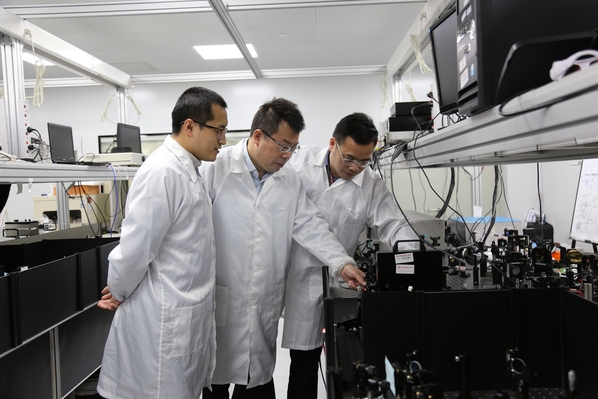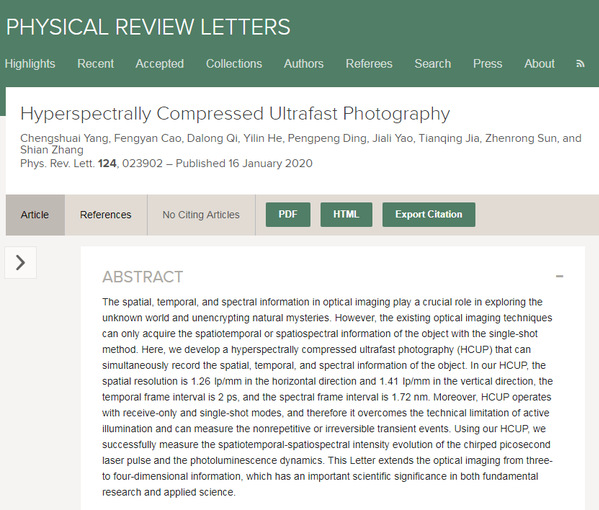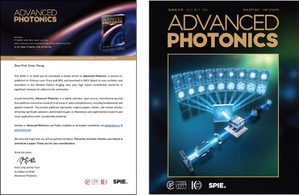
It has long been a dream, as well as a goal, for researchers to capture transient scenes at ultra-high speed. To do so, researchers can discover new natural phenomena, explore new physical processes, and drive new technologies. A team of ECNU researchers, headed by Zhang Shi'an and Sun Zhenrong in the State Key Lab of Precision Spectroscopy, have made a series of important advances in the field of compressed ultrafast photography (CUP).

Qi Dalong (left), Sun Zhenrong (center) and Zhang Shi'an (right) work in the laboratory.
Optical imaging, as a powerful analytical tool to record the details of spatial, temporal and spectral information, plays a crucial role in the exploration and discovery of the unknown world. Researchers have long sought to develop an optical imaging system with high levels of spatial, temporal and spectral resolutions, which holds great potential for advancing fundamental research and applied science.
However, the existing ultrafast optical imaging or hyperspectral imaging technology can only obtain spatiotemporal or spatiospectral information, respectively. Therefore, there is no optical imaging technology that is capable of obtaining high levels of spatial, temporal and spectral information via snapshot.
To overcome thesetechnical limitations, ECNU researchers have developed a hyperspectrally compressed ultrafast photography (HCUP) technology, which can simultaneously record the spatial, temporal, and spectral information of the object in a single shot.
As a burgeoning computational imaging technique, HCUP is based on a compressed sensing theory, which can provide an imaging speed as high as 0.5 trillion frames per second (fps) and a sequence depth of up to a few hundred frames. This technique can extract the temporal, spatial and spectral information of the original dynamic scenes through spatial encoding, data compression and image decoding.
It also features 5×1011 fps inthe temporal frame interval, 1.26 and 1.41 line pairs per mm (lp/mm) in the horizontal and vertical spatial resolutions, and 1.72 nm in the spectral frame interval.
The new technique enables researchers to measure the spatiotemporal-spatiospectral intensity evolution of the chirped picosecond laser pulse and the photoluminescence dynamics for the first time in temporal, spatial and spectral dimensions with a single shot.
The development of HCUP has led to a breakthrough in optical imaging, which can provide strong technical support for the exploration of new scientific phenomena and principles under extreme conditions through the extension from traditional spatiotemporal or spatiospectral information to spatiotemporal-spectral information, it is expected to boost the further development of scientific research and the industry development.
The work was published on January 16 in Physical Review Letters.

CUP is the fastest passive optical imaging technology in the world today. Here, CUP synergistically combines compressed sensing and streak imaging that can capture non-repetitive transient events at 10 trillion fps and up to 350 frames. But in practical applications, it still suffers from obvious defects in core technology.
For example, CUP employs the streak camera, which is subject to the image distortions caused by the coulomb interaction of electrons under high-electron density during photon-electron-photon conversion. On the other hand, China relies on imports for the streak camera, which is currently embargoed by many countries; this has hindered the application of the CUP technology in China, as well as the global marketization of scientific instruments.
To find a way out of this predicament, the ECNU research team led by Zhang Shi'an and Sun Zhenrong developed a new ultrafast electro-optical deflection imaging (UEODI) technology that replaces the streak camera with an electro-optical deflector for imaging detection. It is significant that electro-optical deflectors are independently made in China—at a much lower cost.
The time resolution of the UEODI device is 20 ps, which means that its imaging speed can reach 5×1010 fps. Applying the UEODI system, ECNU researchers unraveled the photoluminescent process of dye molecules. The work has been published inPhysical Review Applied.
In recognition of ECNU researchers' remarkable contribution to the development of CUP, the editor-in chief ofAdvanced Photonics, aprestigious international journal, invited the team to write a review article on their studies entitled Single-shot compressed ultrafast photography: a review, which is the first-ever review paper since the invention of the CUP technology. This study is also selected as the cover story of the journal.

Read the full article:
https://journals.aps.org/prl/abstract/10.1103/PhysRevLett.124.023902
http://dx.doi.org/10.1117/1.AP.2.1.014003
https://journals.aps.org/prapplied/pdf/10.1103/PhysRevApplied.13.024001
Author: Li Jing
Copy editor: Joshua Mayfield
Editor: Yu Wenxi